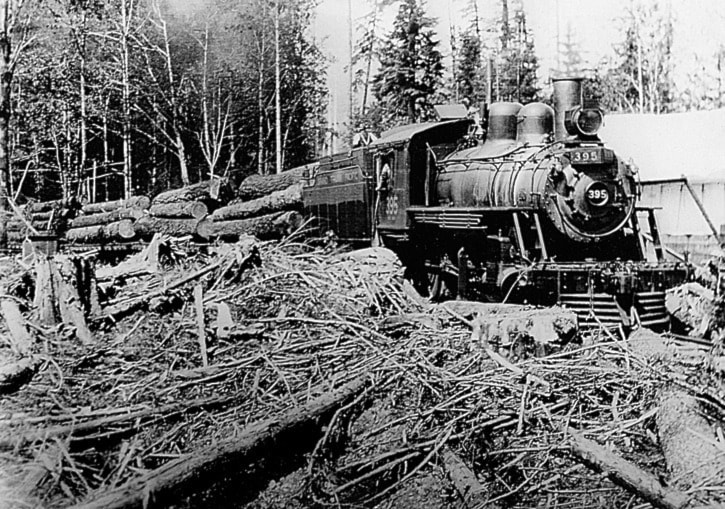The chug-chug and hiss of this steam locomotive hauling flat deck cars loaded with logs was a daily event when this photo was taken in 1920. Felled with cross-cut saws in the watershed of the Sooke River valley, these Douglas-fir logs were destined for sawmills on the outskirts of Victoria. Engine No. 395 was hauling on the Canadian National Railway, first laid out as the Canadian Northern Pacific during World War I.
If you were heading east towards Victoria today, driving on Sooke Road between Woodlands and Harbourview Roads, this scene would be on your left. The standard railway grade had been hewn from the wilderness, ties and rails laid, the line reaching between Sooke Lake, the Cowichan Valley and to Selkirk trestle on the Gorge waterway, to facilitate harvesting of the great conifers of the rainforest.
During its decades of history, the railway carried, besides these limbed logs, poles, pilings and milled lumber from upcountry sawmills. In its busiest period up to the 1940s, two runs were made each day. During its last decade before closing down in the 1970s, munitions offloaded by vessels at Cowichan Bay were hauled by diesel locomotives through the Sooke hills and Metchosin’s pastoral meadows to storage at Rocky Point.
While this scene appears freshly cleared through the woods, the subdivision of Saseenos was surveyed and properties put on the market in 1921. The one-thousand acre subdivision of Saseenos was bisected by Sooke Road, from Idlemore Road to Coopers Cove. Generally, lots on the waterfront side of the road were purchased by people of means, such as retired diplomats or politicians, while the larger acreages on the uplands side were often acquired by immigrants from Europe seeking subsistence farms.
A common thread for all the newcomers establishing their new way of life in Saseenos was the daily thundering run of the locomotives, hooting their warning signals as they approached crossings and slowing to a hissing stop at the Saseenos station. The most treasured sound, though, in the memories of those of us who lived the era, was the steam locomotive’s mournful yet romantic wail as it echoed through the hills.
Elida Peers,
Historian
Sooke Region Museum
